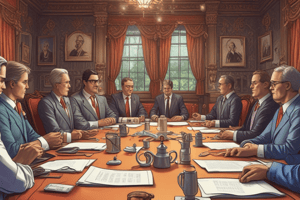Podcast
Questions and Answers
What is the main focus of a servant leader?
What is the main focus of a servant leader?
- The needs of the organization
- The needs of the customers
- The needs of the employees (correct)
- The needs of the shareholders
Who popularized the concept of servant leadership?
Who popularized the concept of servant leadership?
- Robert K. Greenleaf (correct)
- Frederick Taylor
- Elton Mayo
- Max Weber
What is the most important characteristic of a servant leader according to Greenleaf?
What is the most important characteristic of a servant leader according to Greenleaf?
- Making one's main priority to delegate
- Making one's main priority to lead
- Making one's main priority to control
- Making one's main priority to serve (correct)
What is the effect of servant leadership on employee's family life?
What is the effect of servant leadership on employee's family life?
What is the potential downside of servant leadership according to the text?
What is the potential downside of servant leadership according to the text?
What is the effect of servant leadership on employee engagement?
What is the effect of servant leadership on employee engagement?
What is the effect of servant leadership on employee's psychological health?
What is the effect of servant leadership on employee's psychological health?
What is the effect of servant leadership on employee behavior?
What is the effect of servant leadership on employee behavior?
What has research established about servant leadership?
What has research established about servant leadership?
Study Notes
Servant leadership is a leadership philosophy that focuses on serving others. It differs from traditional leadership in that the leader's main focus is on the needs of the employees rather than the organization. Servant leaders share power and help people develop and perform as highly as possible. When leaders shift their mindset and serve first, they benefit as well as their employees in that their employees acquire personal growth, while the organization grows as well due to the employees growing commitment and engagement. Servant leadership was first popularized by Robert K. Greenleaf in 1970, who defined a servant leader as someone who serves others and helps them grow as individuals. Servant leadership has been adopted by many organizations as their way of leadership. According to a 2002 study, servant leadership is being practiced in some of the top-ranking companies, and these companies are highly ranked because of their leadership style and following. The most important characteristic of a servant leader, according to Greenleaf, is making one's main priority to serve rather than to lead. In addition to early definitions and distinct characteristics of servant leaders, researchers and leadership experts have used research to add on to these. Servant leadership is often presented as a particularly ethical leadership style, but it poses several risks and limitations, particularly with regard to ethical issues and dilemmas. Servant leadership practices appear to have an effect on the life of the employee outside of the organizations they are affiliated with. It has been concluded that employee perceptions of servant leadership practices and the support of employers and co-workers have a positive effect on an employee's family life. Servant leadership also contributes to employees' goal achievement and success.Servant Leadership and its Positive Effects on Employees
- Servant Leadership's main concern is the well-being of their employees, which contributes to their success and growth.
- Servant Leaders' management of work environment has a positive effect on employee's well-being and satisfaction.
- Servant Leadership has a positive effect on employee's psychological health by reducing strain and assimilation at the organization.
- Servant Leadership's "bottom-up" style of prioritizing the needs of employees first causes employees to be more engaged in their work.
- Servant Leadership creates a safe emotional work environment for employees by making acceptance a major goal.
- Servant Leaders manage the behaviors of their employees by being forgiving and understanding.
- Servant Leadership affects employees emotionally and encourages them to express themselves in the work place.
- Servant Leadership creates a safe space where employees can be themselves and express how they are feeling.
- Servant Leadership is still considered a "newer" theory among many other theories because of the switch in focus from the traditional leadership theories.
- Research has established Servant Leadership as a valid construct that is worthwhile researching and implementing.
- Servant Leadership research can move forward and continue to offer significant insights to the leadership field over the next 20 years.
- Servant Leadership has been questioned due to its conceptual and empirical overlap with other leadership theories.
Studying That Suits You
Use AI to generate personalized quizzes and flashcards to suit your learning preferences.
Description
How much do you know about Servant Leadership? Test your knowledge on this leadership philosophy that focuses on serving others and prioritizing the needs of employees over the organization. Take this quiz to learn more about the distinct characteristics of servant leaders and their impact on employee well-being, engagement, and success. Challenge yourself to see how much you know about this newer theory of leadership and its potential contributions to the field.




